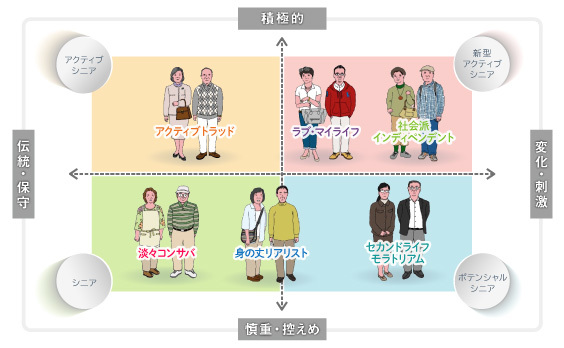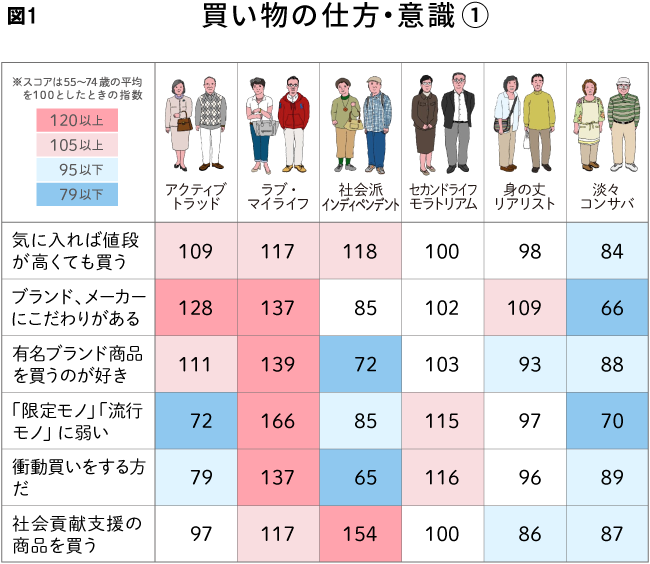In the previous two installments, we discussed the combinations and compatibility of value types among senior "couples." This time, using the latest data from Video Research Ltd.'s "Senior+/ex"*, we will delve deeper into how behaviors and attitudes differ across each segment, split into two parts.
First, we examine differences in attitudes related to "shopping."
The "Senior Value Segments" are... A new approach to understanding the increasingly diverse and complex thinking and behaviors of the senior demographic, segmented by "values." Values are classified into six types, each plotted on a two-axis, four-quadrant model based on "whether behavior is proactive or reserved" and "whether orientation leans traditional/conservative or prefers change and stimulation."

Active Trad: Many are retired and living comfortably, with both money and time. They are proactive in consumption and actions but hold strong traditional family values. This segment most closely matches the image traditionally associated with "active seniors."
Love My Life: Strong pursuit of youth and beauty, anti-aging consciousness, fond of new things, well-informed, and sensitive to trends. One type of "new model" active senior.
Socially-Minded Independent: Values human connections, eager to build new networks and engage in intergenerational exchange. Another pattern of the "new type of active senior."
Unassuming Conservatives: Fully satisfied with their current lives, they desire nothing more. They hold no strong opinions and live each day calmly and peacefully. Closest to the traditional image of "elderly people."
Down-to-earth Realist: Often expresses resignation, saying they don't have money or that something is too expensive to do. They aren't necessarily poor, but their consumption is passive, perhaps due to future anxieties.
Second Life Moratorium: They feel strongly about not wanting to be left behind by society and desire connections with people and communities. However, they don't know how to achieve this and are searching for how to spend the rest of their lives.
Brand-Conscious Love My Life, Ethical Consumer Socially Conscious Independent
Their attitudes and behaviors toward shopping often reflect fundamental differences in how they perceive things—their values (Figure 1).
For example, the three active senior types (Active Trad, Love My Life, Socially Conscious Independent) share the common trait of "buying things they like or feel strongly about, even if they cost more, and making the effort to purchase them." However, the "points that make them like something" differ by type.
For instance, Active Trads, who live comfortably with financial ease, use coupons and discount vouchers less frequently than other types. They tend to be particular about manufacturers and brands, and prefer to buy products from department stores or authorized dealers—places that offer greater "assurance and safety." They rarely make impulse purchases.
Love My Life types, unlike Active Trads, don't meticulously research purchases; they buy without much hesitation when they want something. They prefer novelty and uniqueness, and brand recognition matters. Labeled as "limited edition" or "trendy," items often tempt them, making impulse buys a defining characteristic.
Socially conscious independents, positioned in the same new active senior zone as Love My Life, exhibit shopping attitudes and behaviors completely opposite to Love My Life. They show no interest in branded goods or trends and are the furthest type from impulse buying. However, they respond most strongly to products that are "environmentally friendly" or "contribute to society." Their shopping preferences are truly "socially conscious."
Moratoriums who shop for bargains, and Realists who stick to their means and use mail order
On the other hand, the Second Life Moratorium group makes greater use of "point cards and coupons." While they shop for bargains, as shown in Figure 1, their impulse purchase rate is second only to Love My Life. However, they don't seem as confident in their product selection as Love My Life. They tend to care about others' opinions on their choices and think "if everyone has it, it must be good," showing a strong follower mentality. They might be the type who gets swept up by others and ends up making impulse buys.
Additionally, the "Live Within Your Means Realist" type, who complains "I have no money" yet lives at their own pace, showed high online shopping utilization, with both frequency and amount spent being significant (Figure 3). This type dislikes hassle, so online shopping—which saves the trouble of going out and allows shopping at their preferred time—is likely the perfect shopping method for them.
What seniors need to be attracted is "concreteness" and "convincing arguments"
These characteristics are points that are difficult to discern based solely on demographic traits like age or life stage.
Furthermore, seniors generally have reduced income compared to their working years and rely on pensions and savings for living expenses. Consequently, even if they appear financially comfortable, they are not quick to make purchases. Additionally, their high level of experience and discerning eye mean that to meet their standards, it's crucial to communicate benefits beyond mere functionality. Specifically, it's vital to clearly demonstrate "how their life will improve" and convince them that spending their money is worthwhile, more so than with younger generations. To achieve this, as mentioned earlier, it's vital to recognize that seniors are diverse consumers with distinct perspectives and preferences. Clearly define your target customer profile – who you want buying your product – and then consider what messaging will resonate with their specific inclinations.
For inquiries, please contact us here.
hitoken@videor.co.jp
*About "Senior+/ex"
An age-expanded version of Video Research Ltd.'s large-scale single-source data "ACR/ex".
Survey period: April–June 2017 Location: Tokyo metropolitan area (within 50 km radius) Participants: Men and women aged 55–74 Sample size: N=1611
Survey Method: Randomly selected households based on population composition were visited to request survey cooperation.
Response format: Electronic survey form (using a dedicated tablet device provided).
Video Research Ltd. Hito Research Institute "VR Aging Lab"
A senior research team launched by Video Research Ltd.'s think tank, the Hito Research Institute, aiming to revitalize the senior market. It conducts research activities, disseminates information, and provides consulting services to companies on senior marketing to capture the reality of seniors and apply it to marketing activities.
Hito Research Institute:
http://www.videor.co.jp/hitoken/#anc2








